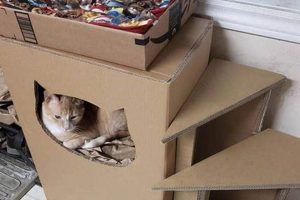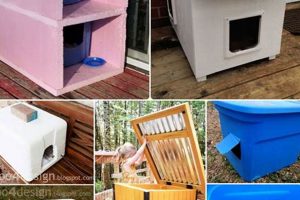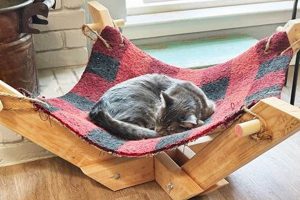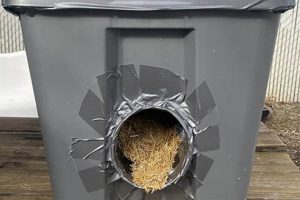Constructing elevated platforms for feline use offers a method for providing pets with dedicated spaces to climb, perch, and observe their surroundings. These structures, often built from wood or similar materials, are designed to be mounted on walls, maximizing vertical space within a dwelling. This concept allows for customized configurations that cater to a cat’s natural instincts and spatial preferences. For instance, a series of staggered platforms can create a climbing route, while a single, high shelf provides a vantage point.
The advantages of such installations are multifaceted. They address the inherent need of felines to explore heights, reducing potential behavioral issues stemming from boredom or lack of environmental stimulation. Furthermore, these platforms contribute to the efficient utilization of limited living spaces, especially in apartments or smaller homes. Historically, cat owners have adapted existing furniture to accommodate their pets’ climbing desires, but the development of purpose-built, wall-mounted structures represents a tailored and aesthetically integrated solution.
The following sections will elaborate on design considerations, material selection, construction techniques, and safety measures relevant to creating these personalized feline environments. The aim is to provide clear guidance for individuals interested in enhancing their cats’ well-being through thoughtful and well-executed spatial design.
Essential Considerations for Elevated Feline Platforms
Effective implementation of wall-mounted feline platforms requires careful planning and execution. The following guidelines are intended to enhance safety, durability, and feline engagement with the constructed environment.
Tip 1: Structural Integrity: Prioritize secure wall anchoring. Employ appropriate hardware, such as wall anchors or screws, based on wall type (drywall, plaster, stud). Weight-bearing capacity should exceed the anticipated load, including the cat’s weight and potential jumping forces.
Tip 2: Material Selection: Choose durable and non-toxic materials. Solid wood or plywood is preferable to particleboard, offering superior stability. Ensure any finishes, such as paint or sealant, are pet-safe and free of volatile organic compounds (VOCs).
Tip 3: Platform Dimensions: Consider the cat’s size and agility when determining platform dimensions. Adequate surface area allows for comfortable lounging and secure landings. A minimum depth of 10 inches and width of 12 inches is generally recommended for an average-sized cat.
Tip 4: Spacing and Arrangement: Strategically space platforms to facilitate natural climbing and jumping movements. Vertical spacing should be appropriate for the cat’s physical capabilities, avoiding excessive leaps that could lead to injury. Consider staggered arrangements to encourage exploration.
Tip 5: Safety Features: Incorporate safety features to prevent falls. Carpeting or non-slip surfaces provide improved traction. Rounded edges minimize the risk of injury in the event of accidental contact.
Tip 6: Observation and Adjustment: Monitor the cat’s interaction with the platforms and make necessary adjustments. Observe climbing patterns and preferences, and reposition platforms as needed to optimize usability and engagement.
Tip 7: Camouflage Cable Management: Integrate cable management solutions to conceal wires and create a safe environment. Use cable clips, ties, and channels to secure exposed cables and prevent cats from chewing on them, which could lead to electric shock or injury.
Adherence to these guidelines contributes to the creation of a secure and enriching environment for feline companions. Prioritizing safety and structural integrity ensures the long-term usability and enjoyment of elevated platforms.
Subsequent sections will address advanced design concepts and aesthetic considerations for integrating elevated feline platforms into existing interior spaces.
1. Structural Security
The fundamental connection between structural security and wall-mounted feline platforms lies in the imperative to ensure the safety and well-being of the animal utilizing the structure. A failure in structural integrity can lead to catastrophic consequences, including falls and potential injuries. Therefore, secure construction is not merely a desirable attribute but a foundational requirement. For example, a shelf constructed with inadequate wall anchors and overloaded with weight risks detaching from the wall, endangering the cat and potentially causing damage to the surrounding environment. The stability of the supports, the quality of the materials and construction, and the method for mounting it on the wall is paramount to safety.
Consider a multi-tiered climbing system designed for larger cat breeds. The cumulative weight distributed across the individual shelves necessitates robust support mechanisms. In such instances, the use of heavy-duty wall anchors, coupled with adherence to recommended weight limits, becomes critical. Regularly inspecting the mounting hardware and platform surfaces for signs of wear or loosening contributes to proactive maintenance and minimizes the likelihood of structural failure. Another practical case is that the support must be compatible with the wall in question, such as drywall vs. concrete. This is where many wall shelves fail.
In conclusion, structural security forms the bedrock upon which successful wall-mounted feline platforms are built. Rigorous attention to detail during design, construction, and installation, combined with ongoing monitoring and maintenance, is essential for mitigating risks and ensuring a safe and enriching environment for feline companions. Any compromise in structural integrity represents a direct threat to feline safety, underscoring the importance of prioritizing secure construction practices. Wall mounted cat shelves are most structurally sound when mounted directly into the wall studs.
2. Material Durability
Material durability directly impacts the longevity, safety, and overall value of wall-mounted feline platforms. The selection of appropriate materials is not merely an aesthetic consideration but a critical determinant of structural integrity and resistance to the demands of feline use.
- Wood Type and Density
The choice of wood influences the platform’s load-bearing capacity and resistance to scratching or chewing. Hardwoods, such as oak or maple, offer superior durability compared to softwoods like pine. Higher density translates to greater resistance to damage and increased lifespan, especially important for larger or more active cats.
- Fastener Strength and Corrosion Resistance
Fasteners, including screws and brackets, are vital components of the structure. Their strength dictates the platform’s ability to withstand stress and prevent separation. Corrosion-resistant materials, such as stainless steel, are preferred to avoid weakening over time due to rust or oxidation, ensuring a secure connection between the platform and the wall.
- Surface Finish and Wear Resistance
The surface finish protects the underlying material from moisture, scratches, and stains. Durable finishes, such as polyurethane or lacquer, offer greater resistance to wear and tear compared to simpler paints or varnishes. Choosing a finish specifically designed for pet environments ensures it is non-toxic and can withstand repeated cleaning without degradation.
- Fabric or Carpet Resilience
If the platform incorporates fabric or carpeting for added comfort and traction, the material’s resilience is critical. High-quality, tightly woven fabrics or durable carpet fibers are less prone to tearing, shredding, or flattening over time. Selecting materials specifically designed for high-traffic areas can significantly extend the lifespan of the platform and maintain its aesthetic appeal.
These considerations underscore the importance of prioritizing material durability when creating wall-mounted feline platforms. Choosing robust materials and finishes not only enhances the safety and longevity of the structure but also reduces the need for frequent repairs or replacements, ultimately providing a cost-effective and sustainable solution for feline enrichment.
3. Platform Dimensions
The dimensional specifications of wall-mounted feline platforms exert a direct influence on their functionality, usability, and safety for feline occupants. Appropriate sizing is paramount to encouraging use and preventing injury, impacting the overall success of these structures.
- Surface Area and Comfort
Insufficient platform surface area can deter cats from utilizing the structure. A platform that is too small may not provide adequate space for comfortable lounging, turning, or grooming. The minimum recommended surface area should accommodate the cat’s fully extended body length plus an additional margin for movement, approximately 10 inches deep and 12 inches wide for an average-sized cat. Larger breeds necessitate proportionally larger platforms to ensure comfort and stability.
- Depth and Stability
Platform depth is crucial for providing a secure landing area during jumping or climbing. Inadequate depth increases the risk of missteps and falls, potentially leading to injury. Platforms intended for higher locations should possess greater depth to instill confidence and provide a more stable base of support.
- Height and Accessibility
The vertical distance between platforms and the floor, or adjacent furniture, directly affects accessibility and usability. Excessive spacing may deter older or less agile cats from attempting to climb. Gradual height transitions and strategically placed intermediate steps can improve accessibility and encourage engagement with the structure.
- Shape and Orientation
While square or rectangular platforms are common, variations in shape and orientation can enhance visual appeal and feline interest. Curved platforms, angled surfaces, or platforms with integrated features like scratching posts or toy attachments can provide additional stimulation and encourage exploration. The platform’s orientation relative to the wall and other platforms should also be considered to optimize traffic flow and minimize potential hazards.
These dimensional considerations are integral to the successful design and implementation of “cat wall shelves DIY” projects. Thoughtful planning and attention to detail ensure that the resulting structure is not only aesthetically pleasing but also functional, safe, and conducive to feline well-being. Ignoring these aspects can lead to underutilization or, worse, potential harm to the intended user.
4. Spatial arrangement
The spatial arrangement of “cat wall shelves diy” directly influences feline engagement and the realization of intended benefits. The placement, spacing, and orientation of these elevated platforms relative to each other and the surrounding environment determine their usability and appeal to cats. An improperly designed spatial arrangement can result in underutilization or even create hazards, undermining the purpose of the installation. For example, shelves positioned too close together may negate the climbing challenge, while those spaced too far apart may discourage use due to a perceived risk of falling. The arrangement should mimic a cat’s natural climbing and perching behavior to be most effective. Consider a real-world scenario where a series of shelves is intended to provide a cat with access to a high window perch. If the shelves are placed in a straight vertical line with minimal offset, the cat may find the climb monotonous and prefer an alternate route, such as jumping directly onto the window sill from nearby furniture. A more successful arrangement might involve staggered shelves with varying depths and heights, creating a more stimulating and physically engaging climb.
Further analysis reveals the practical applications of understanding spatial arrangement in “cat wall shelves diy” projects. Careful consideration should be given to traffic flow within the room, ensuring the shelves do not obstruct human movement. The orientation of the shelves can also impact a cat’s sense of security. Platforms positioned with a clear view of the room allow the cat to observe its surroundings and feel more in control of its environment. In situations where multiple cats reside, strategic placement of shelves can help reduce competition for resources and minimize territorial disputes. Providing multiple climbing routes and perching locations allows each cat to establish its own territory within the vertical space, promoting a more harmonious living environment. This can be seen in the cases where the shelves are connected to cat trees in a “U” shape.
In conclusion, spatial arrangement is a critical component of successful “cat wall shelves diy” projects. It necessitates a nuanced understanding of feline behavior and the careful consideration of environmental factors. While challenges may arise in adapting designs to specific spatial constraints or feline preferences, the resulting benefits of a well-planned spatial arrangement, including increased feline engagement, reduced behavioral issues, and improved space utilization, underscore the importance of prioritizing this aspect in the design and implementation process. Furthermore, a cat may prefer a particular placement depending on the direction the house faces, with a preference for shelves located in areas that get the most sunlight.
5. Feline Safety
Feline safety constitutes a paramount consideration in the design, construction, and installation of wall-mounted cat platforms. The inherent nature of these structureselevated surfaces intended for climbing and perchingintroduces potential risks that necessitate careful mitigation strategies. Failure to adequately address safety concerns can lead to injuries ranging from minor scrapes to severe fractures, thereby negating the intended benefits of environmental enrichment.
- Secure Anchoring and Weight Capacity
Insufficiently anchored platforms represent a significant safety hazard. The anchoring system must possess the capacity to withstand the cat’s weight, as well as the dynamic forces generated during jumping and landing. Wall type, stud location, and anchor selection must align to ensure structural integrity. Regularly inspecting the anchoring system for signs of loosening or wear is essential for maintaining a safe environment. This includes evaluating screws, brackets, and the surrounding wall material for any degradation that could compromise stability.
- Non-Toxic Materials and Finishes
Felines frequently engage in grooming behaviors that may involve licking or chewing on surfaces within their environment. The materials used in constructing cat wall shelves must be non-toxic and free from harmful chemicals. Treated wood, paints, and adhesives should be carefully selected to ensure they do not pose a health risk to the animal. Formaldehyde, lead, and volatile organic compounds (VOCs) are examples of substances to avoid. Certifications such as “low-VOC” or “pet-safe” can provide assurance of product safety. Choosing natural unfinished wood is preferable.
- Slip-Resistant Surfaces
Smooth, slippery surfaces can increase the risk of falls, especially for older or less agile cats. Incorporating slip-resistant materials, such as carpeting, textured paint, or rubberized coatings, improves traction and enhances stability. The selected material should be durable and easy to clean, as well as resistant to shedding or unraveling, which could present a choking hazard. Ensuring adequate grip is crucial, particularly on platforms intended for jumping or transitioning between levels. The best option is to use pet-safe carpet or a natural, grippy wood.
- Rounded Edges and Protected Corners
Sharp edges and corners pose a potential hazard for accidental bumps or collisions. Rounding off edges and covering sharp corners with protective materials minimizes the risk of injury. This is particularly important in areas where the cat is likely to jump or move quickly. Softening hard edges with padding or bumpers provides an additional layer of safety, especially for kittens or senior cats with reduced coordination.
These interconnected safety facets are essential to “cat wall shelves DIY”. Adherence to these principles ensures that the installation contributes to a stimulating and enriching environment without compromising the well-being of the animal. A focus on secure construction, non-toxic materials, slip-resistant surfaces, and edge protection forms the foundation for creating safe and enjoyable elevated spaces for feline companions.
6. Aesthetic integration
Aesthetic integration represents a critical element in the successful incorporation of wall-mounted feline platforms within residential spaces. It moves beyond mere functionality, focusing on harmonizing the structures with existing interior design elements to create a cohesive and visually appealing environment.
- Color Palette Coordination
The selection of colors for the platforms should complement the existing color scheme of the room. This may involve matching wall colors, furniture finishes, or accent pieces. Contrasting colors can also be employed strategically to create visual interest, but should be done with consideration for overall design harmony. An example is choosing natural wood tones for a room with rustic decor or using white platforms in a minimalist space.
- Material Selection and Consistency
The materials used in construction should align with the materials present in the surrounding environment. If the room features hardwood flooring, incorporating wood platforms can create a sense of continuity. Conversely, metal or acrylic platforms may be more suitable for modern or industrial spaces. Consistency in material texture and finish contributes to a unified aesthetic.
- Form and Spatial Harmony
The shape and configuration of the platforms should consider the spatial dynamics of the room. Angular platforms may complement geometric design schemes, while curved platforms can soften the lines of a more traditional space. The arrangement of the platforms should also avoid obstructing natural light or creating visual clutter. Consider how the platforms interact with other design elements, such as artwork or shelving, to achieve a balanced composition.
- Concealed Hardware and Clean Lines
Visible hardware and unfinished edges can detract from the overall aesthetic appeal. Employing concealed mounting systems and ensuring clean lines contribute to a more refined appearance. This may involve using recessed brackets, covering exposed screws, or applying edge banding to raw wood. The goal is to minimize visual distractions and create a seamless integration of the platforms into the space.
By prioritizing aesthetic integration, it is possible to create wall-mounted feline platforms that not only enhance the well-being of the animal but also contribute to the overall beauty and functionality of the home. This holistic approach ensures that the structures are viewed as intentional design elements rather than mere afterthoughts, resulting in a harmonious and enjoyable living environment for both humans and feline companions.
Frequently Asked Questions
The following addresses common inquiries regarding the design, construction, and implementation of wall-mounted platforms intended for feline use. The information presented aims to clarify potential misconceptions and provide guidance based on established best practices.
Question 1: What factors determine appropriate shelf dimensions?
Shelf dimensions are contingent on the cat’s size, weight, and activity level. Insufficient surface area may discourage usage, while excessive dimensions can create instability. A general guideline suggests a minimum depth of 10 inches and a width of 12 inches for an average-sized cat. Larger breeds or multiple cat households require proportionally larger platforms.
Question 2: How can wall-mounted shelves be made safe for cats?
Safety measures include secure anchoring to wall studs or the utilization of appropriate drywall anchors, non-toxic materials, and slip-resistant surfaces. Sharp edges should be rounded or covered to prevent accidental injury. Regular inspection of the installation is crucial to identify and address any signs of wear or loosening.
Question 3: What materials are suitable for building cat shelves?
Solid wood, such as pine or oak, and plywood are common choices. These materials offer sufficient strength and stability. Finishes should be non-toxic and low in volatile organic compounds (VOCs). Avoid using particleboard, as it is prone to crumbling and may contain harmful chemicals.
Question 4: How far apart should cat shelves be spaced?
Spacing depends on the cat’s age, agility, and climbing ability. In general, a vertical distance of 12 to 18 inches between shelves is suitable for most adult cats. Consider incorporating varying heights and staggered arrangements to promote exploration and physical activity.
Question 5: Can wall-mounted cat shelves damage the walls?
Improper installation can result in wall damage. Utilizing appropriate anchors and distributing weight evenly minimizes stress on the wall. It is crucial to locate wall studs for secure mounting. Removing the shelves may leave holes, which can be repaired with patching compound and paint.
Question 6: How do ensure that cats will use wall-mounted shelves?
Placement is key. Locate the shelves near windows, existing furniture, or areas where the cat already spends time. Offering treats or toys on the shelves can encourage initial exploration. Consider the cat’s personality and preferences when designing the layout.
These FAQs address fundamental considerations regarding feline wall-mounted platforms. Prioritizing safety, structural integrity, and feline preferences is crucial for successful implementation.
The subsequent section will detail specific design patterns and construction techniques.
Conclusion
The preceding discussion has elucidated various critical facets of cat wall shelves DIY. From structural integrity and material durability to spatial arrangement and feline safety, a comprehensive understanding of these principles is essential for successful implementation. Aesthetic integration further ensures that these structures not only serve their intended purpose but also complement the existing interior design. The detailed exploration presented provides a foundation for informed decision-making and responsible construction practices.
The creation of elevated feline environments requires meticulous planning and execution. Neglecting foundational elements can lead to safety hazards, structural failures, or a lack of feline engagement. Therefore, a commitment to sound engineering principles, careful material selection, and a thorough understanding of feline behavior is paramount. Thoughtful application of the knowledge shared herein will yield not only functional and aesthetically pleasing cat wall shelves but also enhanced well-being for feline companions.







